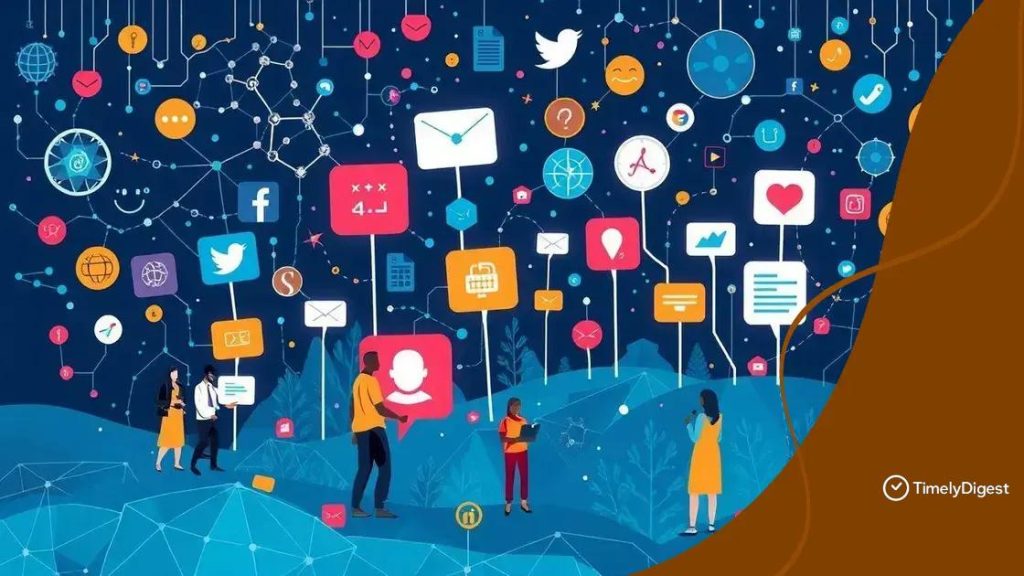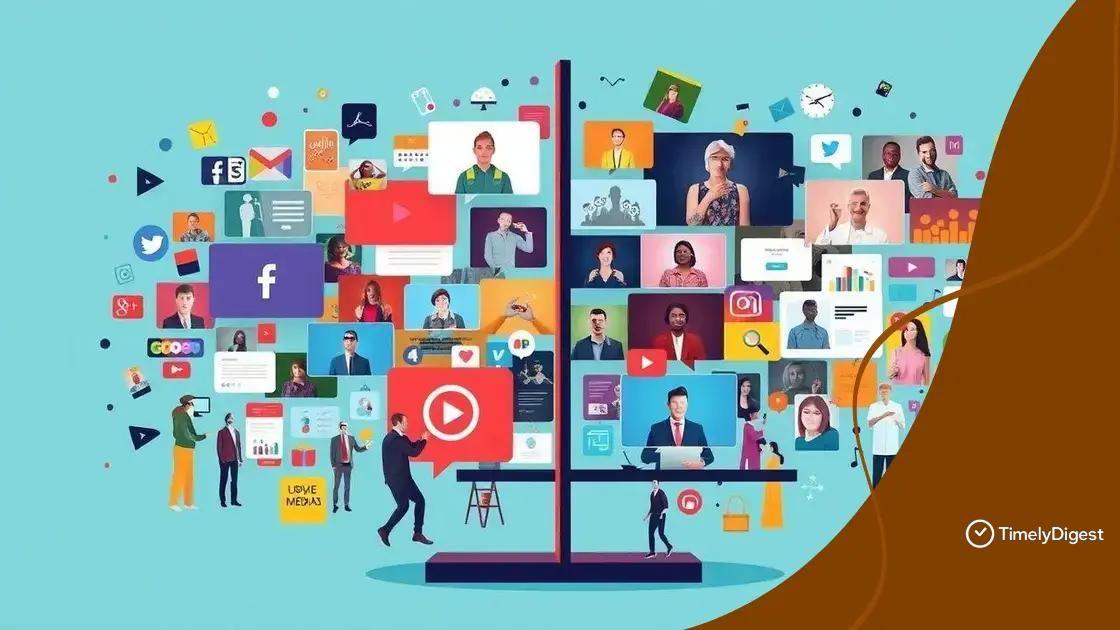The role of algorithms in shaping public opinion

Anúncios
The role of algorithms in shaping public opinion involves personalizing content based on user data, which can create bias and limit exposure to diverse perspectives, highlighting the need for ethical considerations and transparency.
The role of algorithms in shaping public opinion is a topic that affects everyone, whether we realize it or not. Ever wondered how your news feed is curated? It’s time to explore this intricate web.
Anúncios
Understanding algorithms and their impact
Understanding algorithms is crucial as they play a significant role in shaping our online experiences. In simpler terms, algorithms are sets of rules used by computers to solve problems or make decisions. They analyze data and help determine what we see on our screens daily.
Algorithms influence everything from the news we read to the ads we encounter. Their impact is profound, affecting our perceptions and opinions without us even realizing it. As we dive deeper, let’s explore how these algorithms work.
How algorithms function
At the core, algorithms use data to create patterns. This data can come from various sources, such as user behavior, preferences, or even demographics. By analyzing this information, algorithms can tailor content to individual users.
Anúncios
- Algorithms gather user data.
- They analyze patterns in this data.
- They deliver personalized content.
- They adapt over time based on new data.
This personalization can be beneficial, allowing users to find relevant content quickly. However, it can also create echo chambers, where individuals are only exposed to information that aligns with their existing beliefs. In this way, algorithms can influence public opinion subtly but powerfully.
Real-world effects of algorithms
The impact of algorithms is not just theoretical. Real-world examples showcase their influence. For instance, social media platforms use algorithms to decide which posts appear in your feed. This not only shapes what you see but also who you interact with.
Another example is news aggregation sites that utilize algorithms to highlight certain stories over others. This selective exposure can skew public perception and create biases. As users, we must be aware of how algorithms can steer our opinions.
How algorithms influence news consumption
Algorithms play a crucial role in how we consume news today. They help curate content based on our interests, preferences, and online behavior. This targeted approach means that each user’s news feed can look quite different from someone else’s.
As algorithms analyze data, they prioritize stories that align with individual tastes. By doing so, they boost engagement and keep users on platforms longer. However, this can lead to a narrow view of the world. Let’s explore how this process unfolds.
The selection process
News algorithms utilize complex models to decide which stories appear in your feed. These models consider various factors such as:
- User interaction history, including likes and shares.
- Engagement metrics that determine popular stories.
- User demographics and browsing habits.
- The recency of the news articles.
This selection process means that certain perspectives may become more visible, while others fade into the background. As a result, audiences might find themselves in echo chambers, where only familiar viewpoints are reinforced.
The effects of personalized news
The personalization of news can have significant implications. On one hand, it enhances user experience by delivering relevant content. On the other hand, it risks limiting exposure to diverse opinions. When users only see what they agree with, critical thinking may diminish. This phenomenon can substantially shape public discourse.
Furthermore, the influence of algorithms can spread misinformation. If sensationalized stories gain more clicks, they might be prioritized over factual reporting. Understanding the power of algorithms is essential in navigating the modern media landscape. Users must be aware of how these systems work and proactively seek out balanced information.
The balance between personalization and diversity

Finding the right balance between personalization and diversity in content delivery is essential in today’s digital space. Personalization helps tailor news and information to fit individual interests, creating a more engaging experience. However, relying too much on tailored content can limit exposure to different viewpoints.
When algorithms prioritize personalized content, they often favor stories that resonate with users, echoing their existing beliefs. This phenomenon can create a feedback loop where users are only exposed to familiar narratives. To illustrate the importance of this balance, let’s examine how both aspects can coexist.
Importance of diversity in content
Diverse content exposes users to different opinions, cultures, and ideas. A balanced feed can enhance understanding and empathy among individuals. Users benefit from learning about multiple perspectives, helping them form well-rounded views.
- Diverse content fosters open-mindedness.
- It enhances critical thinking skills.
- Exposure to new ideas encourages personal growth.
- Diversity in information can counter misinformation.
Yet, achieving this balance is challenging. Algorithms that focus solely on personalization may inadvertently marginalize less popular viewpoints. Users may miss out on important events or trends that do not align with their interests. Therefore, media platforms need to consider how to integrate diverse perspectives while still catering to user preferences.
Strategies for achieving balance
Media companies and social platforms have a responsibility to strike a balance. One way to do this is through algorithmic adjustments. This can involve implementing features that intentionally diversify users’ feeds. For example, presenting content from sources or topics that users typically do not engage with can broaden their horizon.
Encouraging users to explore new topics can also enhance diversity. Notifications or prompts asking users to read outside their usual preferences can stimulate interest in various subjects. By making conscious efforts to promote both personalization and diversity, platforms can create richer, more informative environments.
Case studies of algorithms in action
Case studies of algorithms illustrate their powerful role in shaping public opinion. By examining specific instances, we can see how algorithms operate in real life and their significant impacts on users and society.
One notable example is the Facebook news feed. The platform uses complex algorithms to determine which posts appear for users based on their interactions. This leads to a personalized experience, but it can also create polarized viewpoints, as users are often only exposed to content that reflects their beliefs.
Algorithmic biases in search engines
Another example can be found in search engines like Google. The algorithms used to rank pages sometimes reflect biases that may affect public access to information. When certain news sources are favored, it can lead to a significant impact on what users see and believe. Studies have shown that search results can favor certain political viewpoints, contributing to societal division.
- Google may prioritize popular news outlets, which can skew perceptions.
- Younger audiences might encounter misinformation when less credible sources dominate.
- Users’ search histories influence their results, limiting diverse viewpoints.
Streaming platforms, such as Netflix, provide another clear case. The recommendation algorithms analyze viewing habits to suggest new content. While this personalization enhances user engagement, it may also lead to a lack of variety. Users might miss out on films or shows that do not match their past preferences, affecting their cultural exposure.
The role of algorithms in political campaigns
Moreover, algorithms play a significant part in political campaigns. Social media platforms utilize algorithms to target specific audiences with tailored ads. This strategy can reinforce existing beliefs and create an environment where misinformation spreads easily. For example, targeted political ads can reach voters based on their online behavior, impacting their electoral decisions.
In summary, case studies reveal that while algorithms enhance user experiences, they also carry risks. Recognizing these implications allows users to approach digital content critically and seek diverse information sources.
Addressing the ethical implications
Addressing the ethical implications of algorithms is crucial as they increasingly influence our lives. With the rise of technology, algorithms shape not only what we see online but also how we think and interact with each other.
One major ethical concern is bias. Algorithms can sometimes reflect or even amplify existing biases present in our society. For instance, if an algorithm is trained on biased data, the outcomes can be unfairly skewed. This can negatively affect marginalized groups, leading to discrimination in areas such as hiring or lending.
The role of transparency
Transparency is vital when it comes to algorithms. Users often don’t know how their data is gathered or how it’s used. Companies must explain how their algorithms work and provide insights into decision-making processes. This accountability can help build trust and empower users to make informed choices.
- Users should know what data is collected about them.
- Companies must clarify how algorithms influence their experiences.
- Transparent algorithms can reduce misinformation risks.
- Understanding algorithms helps users spot potential biases.
Another significant issue is privacy. Many algorithms rely on extensive data collection to provide personalized experiences. However, this collection can compromise user privacy. Striking a balance between personalization and protecting user data is essential.
Regulatory measures
Regulating algorithms is another way to tackle ethical issues. Governments and organizations can set standards to ensure algorithms are fair and just. Regulations can promote ethical practices and provide guidelines on data usage. These measures can lead to fairer outcomes and protect users from harmful practices.
Additionally, educating users about algorithms and their impacts can create a more informed society. Knowledge empowers individuals to critically assess the content they consume and the technologies they use.
FAQ – Questions about Algorithms and Public Opinion
How do algorithms influence what I see online?
Algorithms analyze your online behavior to show you content that matches your preferences, but this can limit exposure to diverse viewpoints.
What are the ethical concerns related to algorithms?
Ethical concerns include bias, transparency, and privacy, as algorithms can reflect existing societal biases and affect user data security.
Why is transparency important in algorithmic processes?
Transparency helps users understand the data collected about them and how it affects their online experiences, fostering trust.
How can I ensure I see diverse viewpoints online?
To see diverse viewpoints, actively seek different sources of information, and consider adjusting your settings or following new content creators.